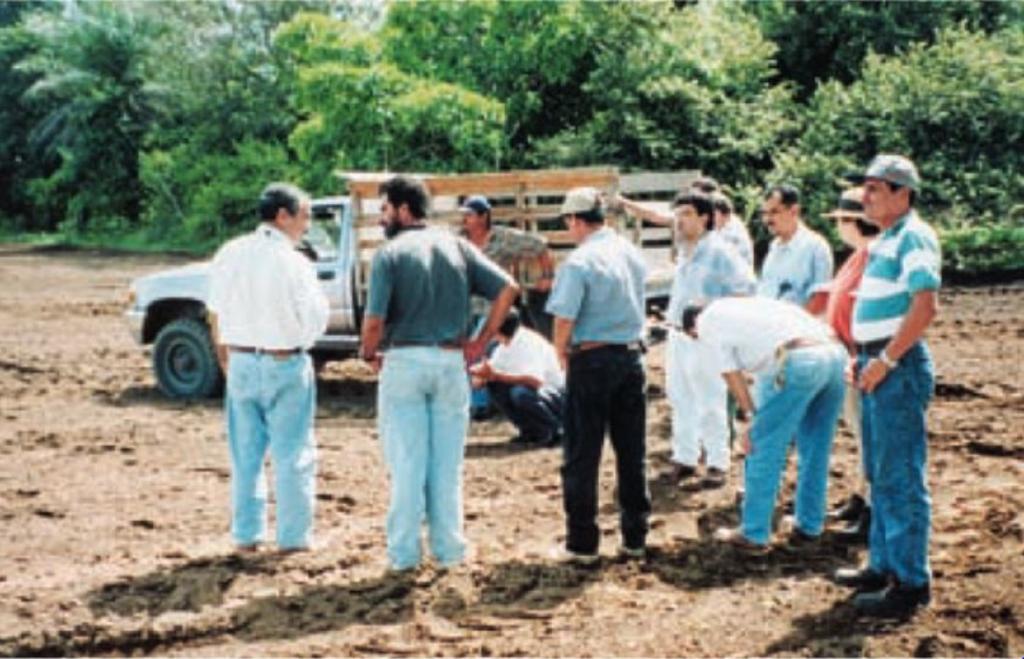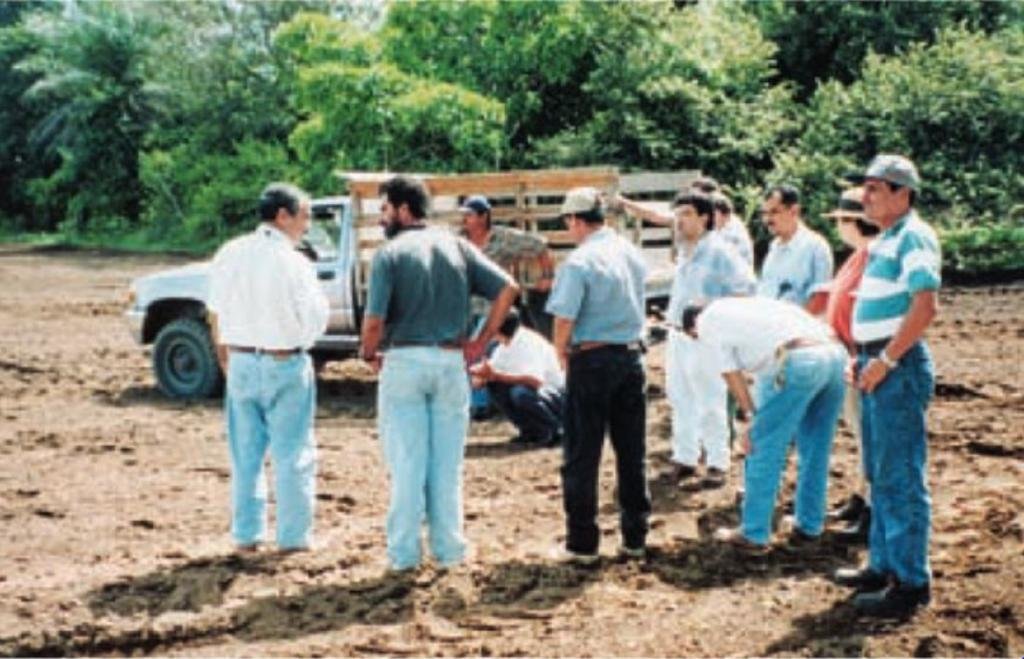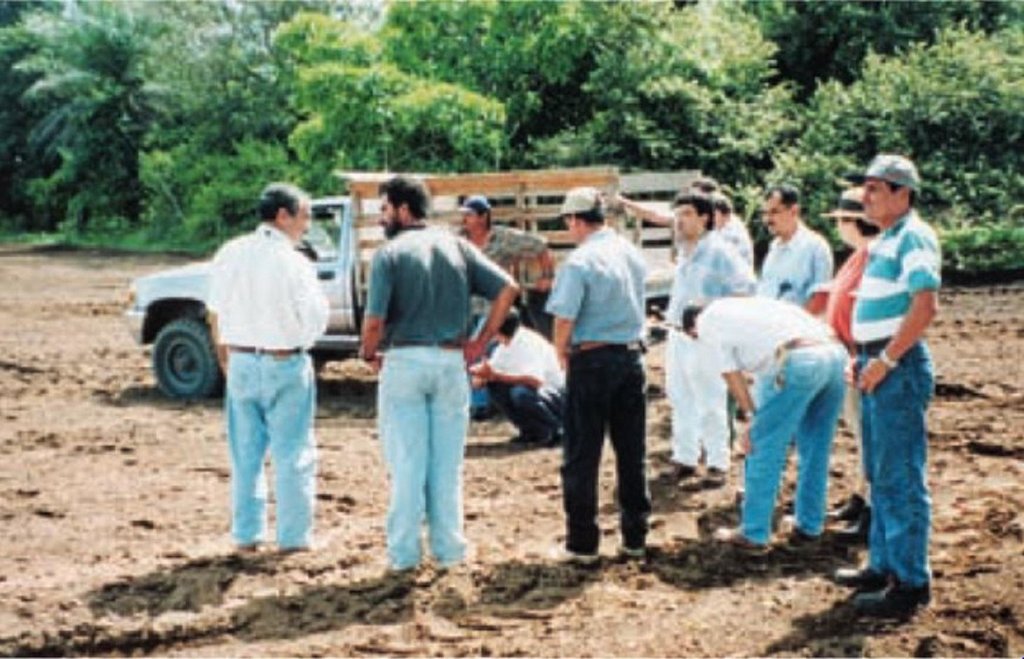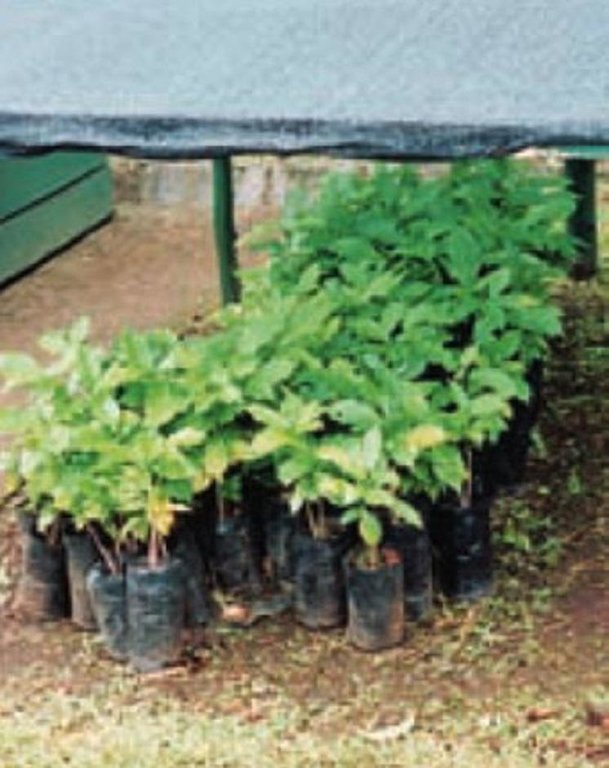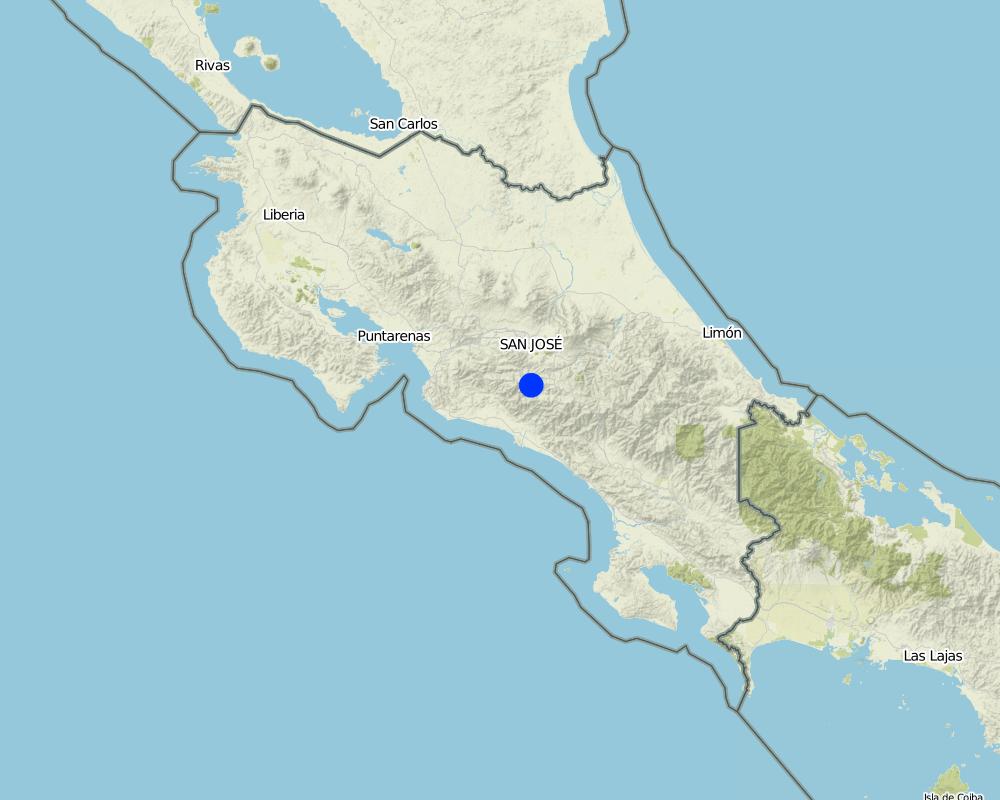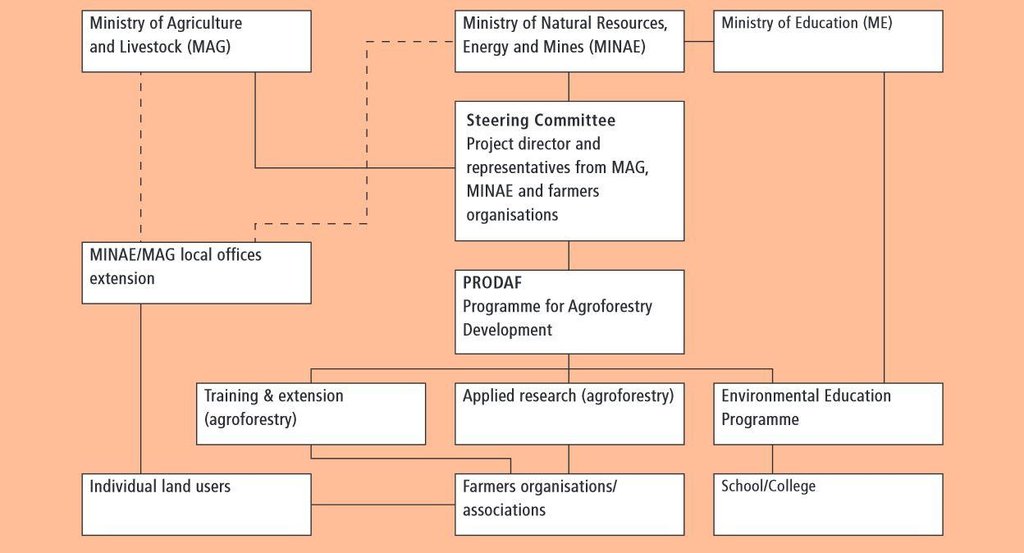Agroforestry extension [哥斯达黎加]
- 创建:
- 更新:
- 编制者: Olman Quiros Madrigal
- 编辑者: –
- 审查者: David Streiff, Deborah Niggli
approaches_2391 - 哥斯达黎加
查看章节
全部展开 全部收起1. 一般信息
1.2 参与方法评估和文件编制的资源人员和机构的联系方式
有助于对方法进行记录/评估的项目名称(如相关)
Book project: where the land is greener - Case Studies and Analysis of Soil and Water Conservation Initiatives Worldwide (where the land is greener)1.3 关于使用通过WOCAT记录的数据的条件
编制者和关键资源人员接受有关使用通过WOCAT记录数据的条件。:
是
1.4 SLM技术问卷的参考
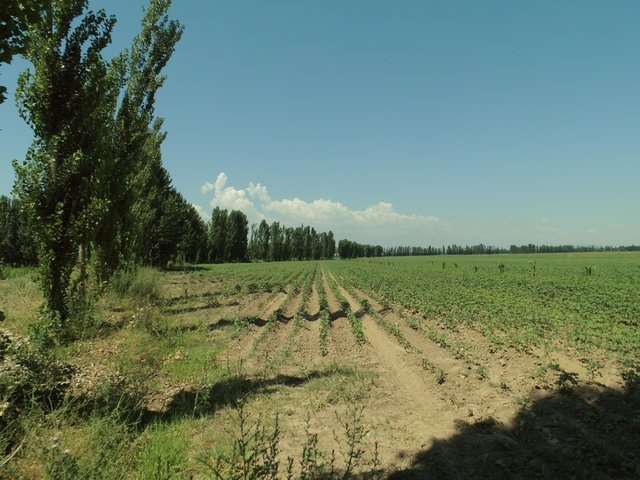
Tree windbreaks within irrigated agriculture in Central Asia [吉尔吉斯斯坦]
Windbreaks of poplar trees (Populus nigra pyramidalis) are a major agroforestry system in irrigated agriculture across Central Asia. Such windbreaks reduce the overall water consumption of irrigated agriculture by 10-20% and increase farm income by 10-15%.
- 编制者: Niels Thevs
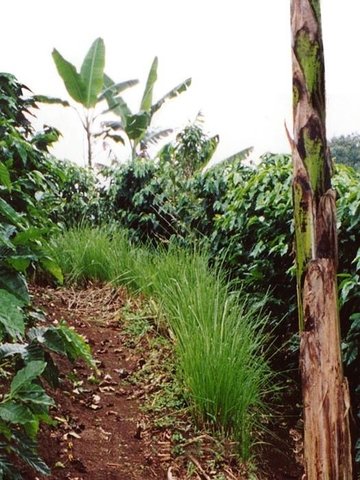
Shade-grown coffee [哥斯达黎加]
An agroforestry system which combines coffee with shade trees - including fruit, timber and leguminous species - in a systematic fashion.
- 编制者: Olman Quiros Madrigal
2. SLM方法的描述
2.1 该方法的简要说明
Participatory extension of agroforestry systems, especially of shadegrown coffee, to promote sustainable and productive use of natural resources among small and medium scale farmers.
2.2 该方法的详细说明
该方法的详细说明:
Aims / objectives: The Programme for Agroforestry Development (PRODAF) pioneered a new type of agroforestry extension in Costa Rica between 1987 and 1994. PRODAF was positioned under two national ministries (the Ministry of Agriculture and Livestock - MAG and the Ministry of Natural Resources, Energy and Mines - MINAE) and was supported by GTZ (German Technical Cooperation). Agroforestry extension underpinned the following sectors: environmental education, promotion of training and technical assistance in agriculture and forestry, development of programmes for afforestation and agroforestry systems, and promotion/support of farmers' organisations. The approach was based on land users' participation at all stages. The main purpose of the agroforestry extension approach was the development and promotion of sustainable production systems, which were adapted to the local biophysical and socio-economic conditions. This was to enable environmentally friendly production on steep slopes, while at the same time generating sufficient income for small and medium scale farmers in marginal areas of the Acosta-Puriscal region. In this case study, shade-grown coffee was identified to be a system that fulfilled these conditions. Another important objective was the involvement of all family members - including the younger generation.
Role of stakeholders: In the first years PRODAF operated with a top-down development approach implementing technologies, designed by specialists, without consultation of land users. Local needs and experiences were not considered: as a result both adoption of shade-grown coffee was low, and maintenance was poor, despite initial incentives. The change to a participatory, bottom-up approach, with land users being represented in the steering committee (which during this period was absolutely innovative) increased acceptance among the majority of farmers towards shade-grown coffee. Participation of land users during planning and implementation was rewarded with provision of tools, seeds, fertilizer and biocides (fully financed or subsidised). The technology was evaluated on the test plots within existing coffee plantations together with the land users. PRODAF's legacy has been an institutional change in Government policy towards extension.
2.3 该方法的照片
2.5 采用该方法的国家/地区/地点
国家:
哥斯达黎加
区域/州/省:
San José/Río Parrita
Map
×2.6 该方法的开始和终止日期
注明开始年份:
1987
终止年份(若不再采用该方法):
1994
2.7 方法的类型
- 基于项目/方案
2.8 该方法的主要目的/目标
Promotion of appropriate management of natural resources and adoption of the shade-grown coffee agroforestry system - café arbolado - among small and medium scale farmers.
The SLM Approach addressed the following problems: - various different approaches of forest and agricultural technicians regarding choice and implementation of the technology, - which needed harmonising, - lack of incentives for farmers to adopt technology, - lack of participatory technology development
2.9 推动或妨碍实施本办法所适用的技术的条件
财务资源和服务的可用性/可得性
- 阻碍
Lack of credit for SWC implementation.
Treatment through the SLM Approach: Credit has been made available through the 'productive re-conversion programme' and other credit systems for organic/conservation production, eg Fideicomiso (see under credit).
机构设置
- 阻碍
Lack of collaboration and coordination between different institutions.
Treatment through the SLM Approach: Innovative incorporation of land users in decision making, which in the meantime has become a common approach.
法律框架(土地使用权、土地和水使用权)
- 启动
The existing land ownership, land use rights / water rights moderately helped the approach implementation: Land fragmentation leads to very small areas per household. This hinders implementation of SWC activities. Land users do not have the resources to invest in initial inputs and activities.
- 阻碍
Subdivision of land hinders adoption of SWC measures.
Treatment through the SLM Approach: Not directly treated by the approach. Diverse incentive mechanisms have to be identified to promote SWC activities on small areas.
了解SLM,获得技术支持
- 阻碍
Lack of technical knowledge, lack of research activities/trials with SWC technologies.
Treatment through the SLM Approach: Promotion of alternative production systems and SWC measures had great impact. Technology was tested on-farm. PRODAF did not focus on research activities.
3. 相关利益相关者的参与和角色
3.1 该方法涉及的利益相关者及其职责
- 当地土地使用者/当地社区
Mainly men participated: women are not usually expected to carry out field activities for cultural reasons. The coffee harvest is the only activity where men and women work together in the field.
- SLM专家/农业顾问
- 国家政府(规划者、决策者)
3.2 当地土地使用者/当地社区参与该方法的不同阶段
| 当地土地使用者/当地社区的参与 | 指定参与人员并描述活动 | |
|---|---|---|
| 启动/动机 | 互动 | rapid/participatory rural appraisal; good participation basically through participative rural appraisal |
| 计划 | 互动 | workshops/seminars; incentives are provided for participating land users |
| 实施 | 互动 | responsibility for major steps; incentives are provided for participating land users |
| 监测/评估 | 互动 | workshop/seminars, interviews/questionnaires; |
| Research | 互动 | on-farm |
3.3 流程图(如可用)
3.4 有关SLM技术选择的决策
具体说明谁有权决定选择要实施的技术:
- 主要是SLM专家,咨询土地使用者之后
解释:
Decisions on the method of implementing the SLM Technology were made by mainly by SLM specialists with consultation of land users
4. 技术支持、能力建设和知识管理
4.1 能力建设/培训
是否为土地使用者/其他利益相关者提供培训?:
是
培训形式:
- 农民对农民
- 示范区域
- 公开会议
培训形式:
- trips to projects in, field days, workshops
涵盖的主题:
The following subjects were treated: coffee agroforestry system, fruit trees and soil conservation, silvo-pastoralism, soil conservation in general. Beside knowledge transfer, awareness raising and motivation were important aims of training.
4.2 咨询服务
土地使用者有权使用咨询服务吗?:
是
指明是否提供了咨询服务:
- 在土地使用者的土地上
说明/注释:
Name of method used for advisory service: Extension carried out through extension workers was the key element of the overall approach; Key elements: the adequacy of extension for continuation was very good, Different methods were used: on-farm technical assistance; farmer-tofarmer knowledge exchange; demonstration areas and workshops.
4.3 机构强化(组织发展)
是否通过这种方法建立或加强了机构?:
- 是,少许
具体说明支持类型:
- 财务
- 能力建设/培训
- 设备
4.4 监测和评估
监测和评估是该方法的一部分吗?:
是
注释:
Bio-physical aspects were ad hoc monitored by 0 through measurements; indicators: yields
Socio-cultural aspects were regular monitored by 0 through observations; indicators: family size
Economic / production aspects were regular monitored by 0 through measurements; indicators: yields and production market
No. of land users involved aspects were regular monitored by 0 through measurements; indicators: land users involved in organisation
There were many changes in the Approach as a result of monitoring and evaluation: The approach changed completely after evaluation of the first phase, from an initial top down methodology with low technology adoption by land users, to a more participative approach heeding land users' opinions and needs, and improving communication between technicians and land users. This was helped by the development of educational materials.
4.5 研究
研究是该方法的一部分吗?
是
明确话题:
- 生态学
- 技术
提供进一步的细节,并指出是谁做的研究:
Results were rather meagre, and the effect on the approach was thus moderate. Previous to PRODAF there was a research project conducted by CATIE (Tropical Agricultural Research and Higher Education Centre) in the approach area, but results were not broadly disseminated.
Research was carried out on-farm
5. 融资和外部物质支持
5.1 该方法中SLM组成部分的年度预算
注释(例如主要的资助来源/主要捐助者):
Approach costs were met by the following donors: government (national - MAG, MINAE): 50.0%; international non-government (GTZ): 50.0%
5.2 为土地使用者提供财政/物质支援
土地使用者是否获得实施该技术的财政/物质支持?:
是
5.3 对特定投入的补贴(包括劳动力)
- 设备
| 具体说明哪些投入得到了补贴 | 程度如何 | 对补贴做出具体说明 |
|---|---|---|
| 工具 | 部分融资 | hand tools |
- 农业
| 具体说明哪些投入得到了补贴 | 程度如何 | 对补贴做出具体说明 |
|---|---|---|
| 化肥 | 部分融资 | |
| seedlings | 充分融资 | |
如果土地使用者的劳动力是一项重要的投入,那么是不是:
- 自愿
5.4 信用
是否根据SLM活动的方法给予信用值?:
是
对条件(利率、回报等)进行具体说明:
Repayment conditions: Credit was provided through ‘productive re-conversion programme’ to support small-scale organic production and soil conservation. After PRODAF a larger (national) credit programme to promote agroforestry systems was launched, under MAG and National Production Council. Fideicomiso is another national financing programme based on a contract between a bank and development institutions. .
Interest was lower than market rate.
6. 影响分析和结论性陈述
6.1 方法的影响
该方法是否帮助土地使用者实施和维护SLM技术?:
- 否
- 是,很少
- 是,中等
- 是,支持力度很大
There was substantial improvement of soil and water management through application of the agroforestry systems.
Did other land users / projects adopt the Approach?
- 否
- 是,很少
- 是,中等
- 是,支持力度很大
Some projects in the region as well as in other parts of the country adopted the approach. Various SWC extension programmes have adopted the extension methods promoted by PRODAF, based on the principles of land users participation. In the Ministry of Agriculture and Livestock it has been taken as a basic principle in the National Programme of Agricultural Extension.
6.3 方法活动的可持续性
土地使用者能否维持通过该方法实施的措施(无外部支持的情况下)?:
- 不确定
若否或不确定,请具体说明并予以注释:
While the approach has been institutionalised and a national credit programme set up promoting shade-grown coffee and silvo-pastoral systems, continuation of field production activities is uncertain. Farmers’ motivation to apply technologies was raised with the Environmental Education Programme, but if market prices for coffee decrease /show variability, farmers lose the motivation to maintain i
6.4 该方法的长处/优点
| 编制者或其他关键资源人员认为的长处/优势/机会 |
|---|
| Institutionalisation of the basic participatory extension approach within the Ministry of Agriculture and Livestock. |
| Initial top-down approach replaced by participation with land users (How to sustain/ enhance this strength: Continue to spread information about the effectiveness of this change in attitude, and the need for responsiveness in projects and programmes.) |
| Training of land users (knowledge of soil degradation processes and soil and water conservation) (How to sustain/ enhance this strength: Collaboration with farmers organisations, NGOs and agricultural extension services. Better dissemination of research results.) |
| Environmental education in schools (How to sustain/ enhance this strength: Continue support through the Ministry of Education.) |
6.5 该方法的弱点/缺点以及克服它们的方法
| 编制者或其他关键资源人员认为的弱点/缺点/风险 | 如何克服它们? |
|---|---|
| No economic security guaranteed in the long term because of price fluctuations | Provide a system of incentives, eg lower taxes for those who apply SWC technologies. |
7. 参考和链接
7.1 方法/信息来源
- 实地考察、实地调查
- 与土地使用者的访谈
7.2 参考可用出版物
标题、作者、年份、ISBN:
PRODAF (1992) Informe de evaluación de las parcelas agroforestales establecidas por PRODAF, Periodo 88-91, Puriscal,Quiros O (2000) Nachhaltigkeit von landwirtschaftlichen Produktionsverfahren in bäuerlichen Familienbetrieben in Costa Rica.
可以从哪里获得?成本如何?
Vauk-Kiel KG: series of: Sozialökonimische Schriften zur Ruralen Entwicklung, Vol. 20
链接和模块
全部展开 全部收起链接

Tree windbreaks within irrigated agriculture in Central Asia [吉尔吉斯斯坦]
Windbreaks of poplar trees (Populus nigra pyramidalis) are a major agroforestry system in irrigated agriculture across Central Asia. Such windbreaks reduce the overall water consumption of irrigated agriculture by 10-20% and increase farm income by 10-15%.
- 编制者: Niels Thevs

Shade-grown coffee [哥斯达黎加]
An agroforestry system which combines coffee with shade trees - including fruit, timber and leguminous species - in a systematic fashion.
- 编制者: Olman Quiros Madrigal
模块
无模块


